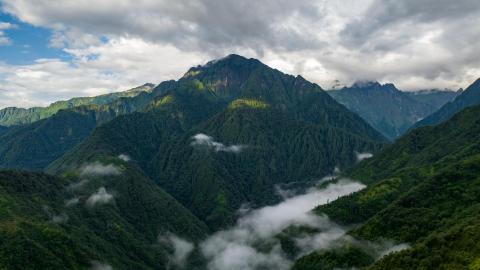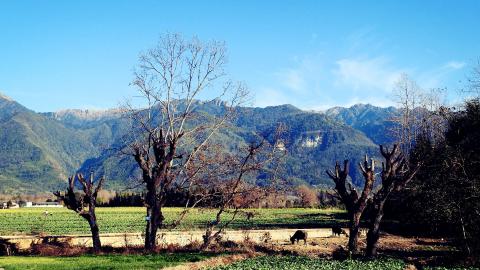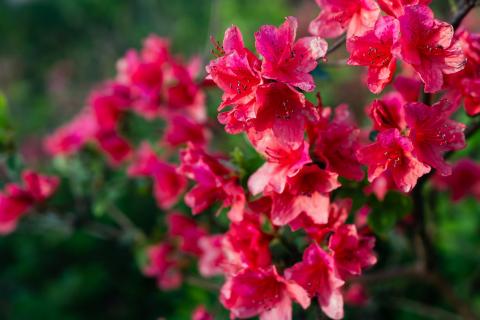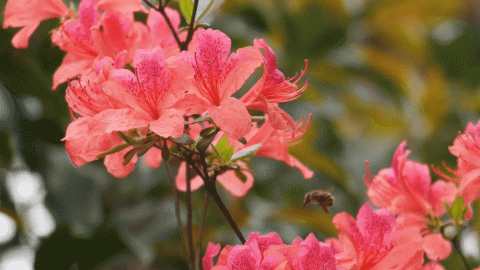According to ancient legend, human and animals board Noah's Ark to escape the Flood, which will drown the world. Scientists say, in a long prehistoric ice age, many endangered species found their ancient ark - the Gaoligong Mountain - and survived there. Ten million years later, we found that they have disappeared in other parts of the earth, but still living in Gaoligong Mountain.
A bird's eye view of Gaoligong Mountains and Nu River

Before I left for Gaoligong Mountain, I read a book called "Human's Two-sided Bookshelf ─ Interpretation of Gaoligong Mountain," written by Fan Wen. The book interprets that: "The giant long Gaoligong Mountains originate from the Boxoila Ling at the southeast end of Qinghai-Tibet Plain. And in sunny days, you can look far away to see the snowy mountain in Tibetan regime?."
In fact, I've climbed Gaoligong Mountain many times, but I didn't see those towering snow peaks in Tibet, unless standing on the 5,128 metre high Gargap Peak. As the most important mountain range in the Hengduan Mountain Range, its significance is in bordering rather than looking in the distance at a high point. When you stand at the top of Gaoligong Mountain, one step eastwards will take you to the Eurasian continent, and one step westwards will take you to the Indian continent. Hundreds of millions of years ago, these two continents drifted and collided, resulting in the rise of the Gaoligong Mountains, from north to south, from the deep sea. Gaoligong Mountain is the most spectacular wall, which separates the two key Asian regions, on the earth.
Gaoligong Mountain, South Zhaigongfang

Now let's look at the north-to-south direction, the Gaoligong Mountains originate from north to south, diving from the Tibet plateau to the Indochina peninsula, over 600 km long, and its slim stature spans five latitudinal transects.
A metaphor is used to describe it: the Gaoligong Mountain is a huge bridge connecting the Qinghai-Tibet Plateau and the Indochina Peninsula. Of course it is a "god-build" bridge. In the eyes of ecologists in the world, the east Himalayan region is one of the top ten key regions that have the richest species in the world, as comparable to the South America Amazon region, and Gaoligong Mountain is exactly on the eastern front of the Himalayan region. No other mountain can be like Gaoligong Mountain in the aspect of rich but relatively disparate natural condition: being snowy all year round in the northern part; extending into subtropical jungle in the southern part; rainy and heavily covered by plants in the western part due to warm wet and humid air streams from the Indian Ocean; and a typical dry-hot valley climate of the Nu River valley in the eastern part.
The climate diversity determines the diversity of species, as many as tens of thousands of kinds of animals and plants. Scientists call it the "north-south corridor for plants and animals." When severe geological movements happened in the earth, Gaoligong Mountain became a "refuge" for plants and animals from four cardinal points, thus many endangered species are preserved in the Gaoligong Mountain, making it famous as a rare animal shelter, a natural botanical garden and a species gene pool.
Gaoligong Mountain National Nature Reserve has priority protection status among China's numerous nature reserves, its biological diversity has a pivotal position in China, thus it was listed as a A level reserve, of international significance, by the World Wildlife Fund, and was admitted for "members of the world biosphere reserve" by UNESCO.
Gaoligong Mountain, Immense Forest

George Forrest, coming from remote England, was the first person to interpret Gaoligong Mountain. In 1904, George Forrest was assigned by the Edinburgh Botanical Garden to Gaoligong Mountain in Yunnan.
He spent 28 years reading the mystery of the mountain. During this time, he organised seven large collections of plants and animals, in which over 100,000 kinds of plant specimens were collected in the Gaoligong Mountain area. Also, more than 10,000 animal specimens were taken, especially birds, as well as 30,000 specimens of seeds.
These were then delivered to Europe, to the UK. At that time, the President of the British Royal Geographical Society published an article and praised him: “Thanks to Mr. George Forrest's hard work which makes the European garden so brilliant.”
Rhododendron

The global popularity of Gaoligong Mountain is largely because of the Rhododendron Giganteum, which is known as the king of azaleas.
It is known as a natural garden for them, with nearly 200 different kinds of rhododendron. In 1907, Forrest found a giant tree-like rhododendron when he was doing some collection work in Datang on the west slope of Gaoligong Mountain. He collected this rhododendron and made a disc specimen, and delivered it to the UK, to the Edinburgh Botanical Garden.

After appraisal by authoritative experts in rhododendron, they jointly published an article and named it as Rhododendron Giganteum. Rhododendron Giganteum was displayed as a specimen in the British Museum since it was founded in 1907 and got its name. And British people were proud of it as it was an "out-of-print" edition envied by botanists over the world.
Since the Rhododendron Giganteum was exhibited in the museum, it was thought to be the largest specimen in the world before the 1980s. Therefore, the British people remained proud of this for the whole 74 years. Because no one found such Rhododendron Giganteum after Forrest.
Although it must be growing in somewhere in China, but none of the people, or to say of the experts, knew where it was until the year of 1981, when Chinese people finally found the Rhododendron Giganteum again on the Gaoligong Mountain.
The Rhododendron Giganteum found by Forrest had a diameter of 87 cm, while the current one has diameter up to 305 cm.
The Gaoligong Mountain not only breeds world famous Rhododendron Giganteum, but also is the habitat for Yunnan mountain tea. Any specific kind of artificial cultivated camellia can find its corresponding primitive variety here.
Also, there is the millennium king of Taiwania Flousiana, king of gingko growing here, towering to the sky in a broad manner.
Walking onto the Gaoligong Mountain, it's like walking into a giant picture with the spirit of mountain and water. What's in front of you is the mysterious virgin forest, the appearing and disappearing birds and animals, the flowing water and falls making sounds in the valley, the high mountain steaming hot spring, and the three-dimensional climate of "four seasons in one mountain and different weather every ten miles," as well as the gorgeous wild flowers as splendid as rosy clouds.
You can feel the vicissitudes and romantic charm of Gaoligong Mountain when you are roaming on the moss-covered ancient road, wiping off dust from the broken steles corroded in wind and snow, and when you stop at the legacy of blockhouses and bunkers in the Sino-Japanese War.
It is hard to describe the charm of Gaoligong Mountain in words, for this great mountain range in western China does not obtain its greatness by bestowment from emperors or by monumental work of scholars. What's more meaningful about it is something coming from the earth, from nature and from beings.

